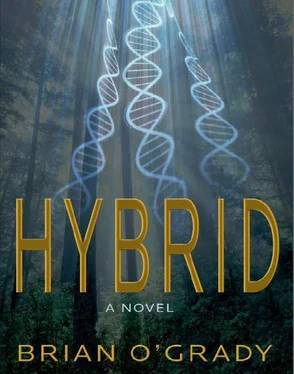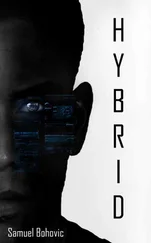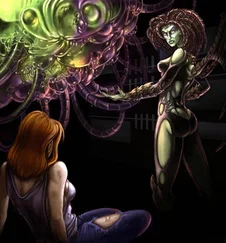Brian O'Grady - Hybrid
Здесь есть возможность читать онлайн «Brian O'Grady - Hybrid» весь текст электронной книги совершенно бесплатно (целиком полную версию без сокращений). В некоторых случаях можно слушать аудио, скачать через торрент в формате fb2 и присутствует краткое содержание. Год выпуска: 2011, ISBN: 2011, Жанр: Триллер, на английском языке. Описание произведения, (предисловие) а так же отзывы посетителей доступны на портале библиотеки ЛибКат.
- Название:Hybrid
- Автор:
- Жанр:
- Год:2011
- ISBN:1936558041
- Рейтинг книги:4 / 5. Голосов: 1
-
Избранное:Добавить в избранное
- Отзывы:
-
Ваша оценка:
- 80
- 1
- 2
- 3
- 4
- 5
Hybrid: краткое содержание, описание и аннотация
Предлагаем к чтению аннотацию, описание, краткое содержание или предисловие (зависит от того, что написал сам автор книги «Hybrid»). Если вы не нашли необходимую информацию о книге — напишите в комментариях, мы постараемся отыскать её.
Hybrid — читать онлайн бесплатно полную книгу (весь текст) целиком
Ниже представлен текст книги, разбитый по страницам. Система сохранения места последней прочитанной страницы, позволяет с удобством читать онлайн бесплатно книгу «Hybrid», без необходимости каждый раз заново искать на чём Вы остановились. Поставьте закладку, и сможете в любой момент перейти на страницу, на которой закончили чтение.
Интервал:
Закладка:
It took him another two hours to sort through the slides. “Addendum to previous report. Contributing cause of death: viral encephalitis, type unknown. End dictation.” They would have to give this infection a name, but that would have to be done later. Right now, he had a different responsibility: to report this to the CDC. If they cared to give it one of their usual catchy names, then so be it. Actually, that honor belongs to Henry Gorman , Phil thought, surprised that it had slipped his mind. He picked up the phone and dialed the main number for the Centers for Disease Control and Prevention in Atlanta. It was after hours, and as expected, the operator routed him to the voicemail of Nathan Martin’s Special Pathogens Division. Phil left a brief voicemail and hung up. His next call was to the Colorado Department of Health, and he was annoyed to find that they, too, were closed. He left his second voicemail, which was considerably more terse than the first, and then returned to the slides. He reviewed the nine that showed the clearest signs of infection; all nine came from the brain. The virus was to small to be seen with a light microscope, so he would have to wait for the electron micrographs to confirm that it was Gorman’s virus that was causing the profound inflammatory reaction at the base of the brain. It was curious that the worst parts of Peter Bilsky’s brain were the ones most associated with memory and emotions. His thalamus, hypothalamus, and amygdaloid nuclei, along with both hippocampi, were almost liquefied.
Phil began to wonder how Bilsky had survived so long. He changed objective lenses to his highest power and began to review the morphology of the individual nerve cell bodies. He started with those closest to the ventricles, but the architecture was so disturbed that he began to scan outward. The further he moved away from the fluid-filled cavities, the closer the anatomy conformed to normal.
Melissa Shay, the department’s senior lab tech, quietly walked into the reading room and placed a tray of slides next to Phil. He felt her presence and looked up.
“I did a KL-124 stain on some of these,” she said. The KL124 stain was a good multipurpose stain that made inflammatory cells appear blue. “He’s got loads of inflammation, but there’s something strange going on here. You should look at these six slides.”
Phil took the first of the six slides and held it up to the ceiling light. It was almost entirely blue. “Curious,” he said. He replaced the slide that he had been scanning with the new one.
Melissa waited. Normally, Phil worked in complete isolation, but she was intrigued enough to violate his workspace, and to her surprise, he allowed it.
Phil made a preliminary inspection and confirmed that Melissa hadn’t made a mistake during the staining process, and then he focused down to the cells. As expected, the brain tissue was rife with the small blue lymphocytes indicative of a viral infection, but there was something else, something that shouldn’t be there. A thick band of large, blue-stained neurons lined the walls of Peter Bilsky’s ventricles. Phil looked up from the microscope.
“It doesn’t make any sense, but I think that’s germinal matrix,” Melissa said.
Normally, the brain developed from a thin layer of cells called the germinal matrix. Never more than a few cell layers thick, all the neurons a person would ever have derived from these stem cells. The problem was that the germinal matrix all but disappears in infancy, and yet Peter Bilsky had a thick layer of these very special cells lining the walls of his adult ventricles.
Phil returned to the scope. The stem cells were so densely packed around the ventricles that nothing normal remained, but two to three millimeters away, the inflammation predominated. It was two sides of the same coin. A destructive inflammatory process initiated by an unknown virus, and a regenerative process that had no business being there.
“These are stained as well?” He pointed to the remaining slides in the tray.
“Most of them, but only these six are from the brain.” Melissa was getting excited, sensing that they were on to something new and important.
“Right now, I’m more interested in the rest of the samples.” He made eye contact with her, and she blushed.
“I’ll have them out in fifteen minutes,” she said, enjoying their tiny moment of closeness.
Phil spent the next fifteen minutes looking more closely at all the remaining slides, but found nothing of interest. Melissa brought twenty newly stained slides and discreetly took a chair while Phil reviewed them. He was allowing her unprecedented access, and even though it was long after five, she had no interest in relinquishing it.
An hour passed, and finally he pushed back away from the microscope. “With the exception of a small segment of bone marrow, everything else is normal,” he said to Melissa without looking at her.
“The marrow is supposed to have some stem cells?” she asked.
“Not like these, and not clustered so tightly. The virus seems to involve the bone marrow as well as the brain.”
It was a curious puzzle, and Phil didn’t see any obvious connection. It was true that both the bone marrow, which was responsible for the production of the red and white blood cells, and the germinal matrix, both derived from the same embryonic layer; but beyond that, the brain and bone marrow had little in common. Plus, there were other tissues that also arose from the same embryonic layer, and all of them were normal.
“Is it neoplastic, maybe some kind of lymphoma of stem cells?” Melissa offered.
“No, it’s not a tumor. The organization is too complex.” Phil rubbed his eyes. “This is something that I’ve never seen before.”
“We have slides from two other cases that came in today, both presumed suicides. Dr. Faraday was going to review them in the morning, but I’m sure he wouldn’t mind if you looked at them tonight.”
“It’s after seven,” Phil said.
Melissa glanced up at the clock, and it was long after seven. “This is important,” she said. “Besides, I’ve got no one waiting on me at home, except for a very lazy border collie.” She left to get the other slides.
Phil wondered why she had no one at home. Maybe she was married and her husband was out of town, or working late. Maybe she was a widow. Maybe she had never married at all. Melissa had worked for the coroner’s office for eleven years, longer than he had been there, and he was surprised by how little he knew about her. He should have picked up more about her personal life just through overheard casual conversations. So why didn’t he know even the most basic information about her? He waited for an answer, but none of his Monsters, not even the smart, small voice, responded. He knew the answer, of course, but he shrank from it. Melissa wasn’t important to him; she wasn’t a part of the small and carefully maintained Phillip Rucker universe. She was a functionary, no more critical to him than this microscope. At an abstract level, he knew that she was more important than a microscope, but he didn’t — he couldn’t — live in an abstract world. His behavior and thoughts were ruled by the concrete codes of Personal Responsibility and The Routine.
Phil stood and stretched his sore, stiff back; at least that hadn’t changed. It dawned on him that this was the second time that day that he had found himself exploring beyond the borders of the Phillip Rucker universe, and he was surprised by how far he could venture beyond the usual narrow range of safe-thought without reprisal.
Melissa returned. “Here is the first set,” she said and placed a rack of slides next to his microscope. Phil noticed a small stripe of lighter skin on her left fourth finger.
Читать дальшеИнтервал:
Закладка:
Похожие книги на «Hybrid»
Представляем Вашему вниманию похожие книги на «Hybrid» списком для выбора. Мы отобрали схожую по названию и смыслу литературу в надежде предоставить читателям больше вариантов отыскать новые, интересные, ещё непрочитанные произведения.
Обсуждение, отзывы о книге «Hybrid» и просто собственные мнения читателей. Оставьте ваши комментарии, напишите, что Вы думаете о произведении, его смысле или главных героях. Укажите что конкретно понравилось, а что нет, и почему Вы так считаете.












